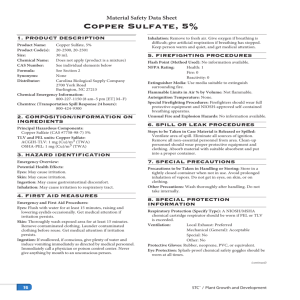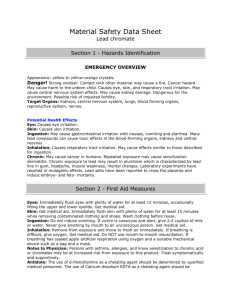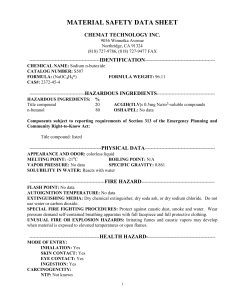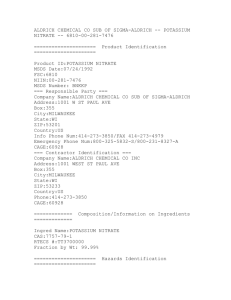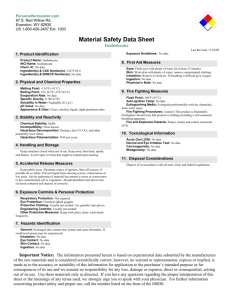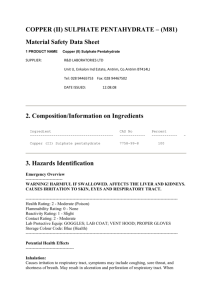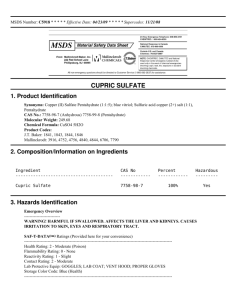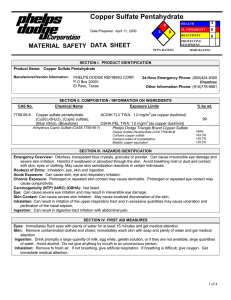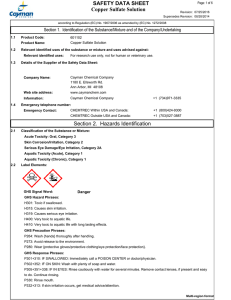Copper Sulfate Pentahydrate MSDS | Safety Data Sheet
advertisement
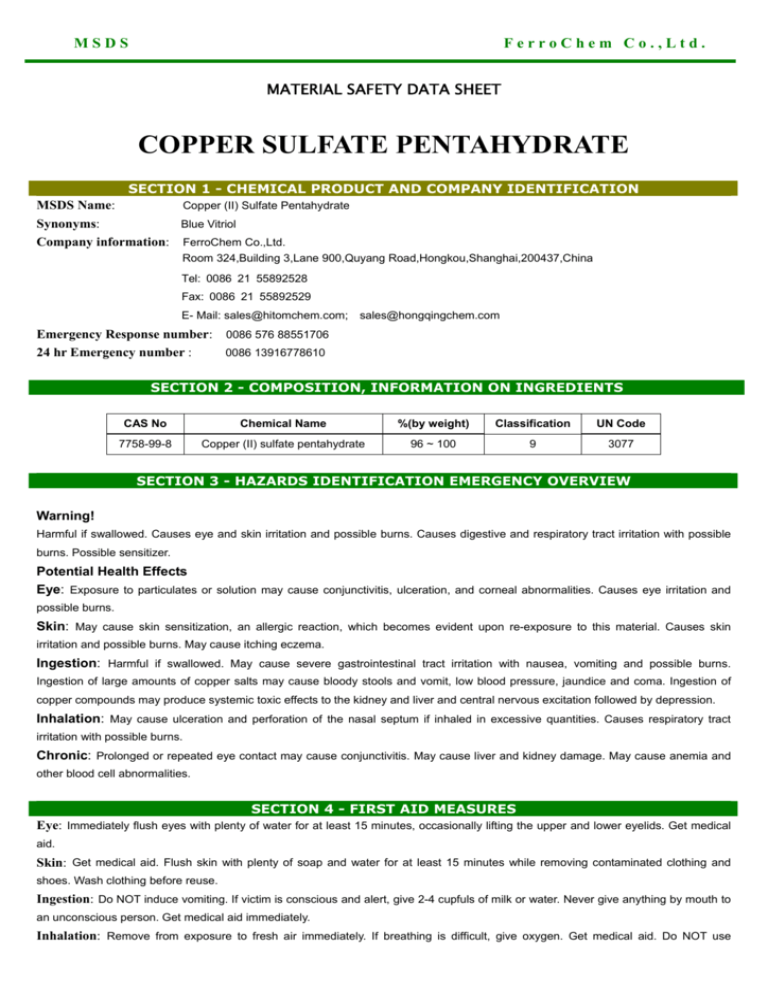
MSDS FerroChem Co.,Ltd. MATERIAL SAFETY DATA SHEET COPPER SULFATE PENTAHYDRATE SECTION 1 - CHEMICAL PRODUCT AND COMPANY IDENTIFICATION Copper (II) Sulfate Pentahydrate MSDS Name: Synonyms: Blue Vitriol Company information: FerroChem Co.,Ltd. Room 324,Building 3,Lane 900,Quyang Road,Hongkou,Shanghai,200437,China Tel: 0086 21 55892528 Fax: 0086 21 55892529 E- Mail: sales@hitomchem.com; sales@hongqingchem.com Emergency Response number: 0086 576 88551706 24 hr Emergency number : 0086 13916778610 SECTION 2 - COMPOSITION, INFORMATION ON INGREDIENTS CAS No Chemical Name %(by weight) Classification UN Code 7758-99-8 Copper (II) sulfate pentahydrate 96 ~ 100 9 3077 SECTION 3 - HAZARDS IDENTIFICATION EMERGENCY OVERVIEW Warning! Harmful if swallowed. Causes eye and skin irritation and possible burns. Causes digestive and respiratory tract irritation with possible burns. Possible sensitizer. Potential Health Effects Eye: Exposure to particulates or solution may cause conjunctivitis, ulceration, and corneal abnormalities. Causes eye irritation and possible burns. Skin: May cause skin sensitization, an allergic reaction, which becomes evident upon re-exposure to this material. Causes skin irritation and possible burns. May cause itching eczema. Ingestion: Harmful if swallowed. May cause severe gastrointestinal tract irritation with nausea, vomiting and possible burns. Ingestion of large amounts of copper salts may cause bloody stools and vomit, low blood pressure, jaundice and coma. Ingestion of copper compounds may produce systemic toxic effects to the kidney and liver and central nervous excitation followed by depression. Inhalation: May cause ulceration and perforation of the nasal septum if inhaled in excessive quantities. Causes respiratory tract irritation with possible burns. Chronic: Prolonged or repeated eye contact may cause conjunctivitis. May cause liver and kidney damage. May cause anemia and other blood cell abnormalities. SECTION 4 - FIRST AID MEASURES Eye: Immediately flush eyes with plenty of water for at least 15 minutes, occasionally lifting the upper and lower eyelids. Get medical aid. Skin: Get medical aid. Flush skin with plenty of soap and water for at least 15 minutes while removing contaminated clothing and shoes. Wash clothing before reuse. Ingestion: Do NOT induce vomiting. If victim is conscious and alert, give 2-4 cupfuls of milk or water. Never give anything by mouth to an unconscious person. Get medical aid immediately. Inhalation: Remove from exposure to fresh air immediately. If breathing is difficult, give oxygen. Get medical aid. Do NOT use mouth-to-mouth resuscitation. If breathing has ceased apply artificial respiration using oxygen and a suitable mechanical device such as a bag and a mask. SECTION 5 - FIRE FIGHTING MEASURES General Information: As in any fire, wear a self-contained breathing apparatus in pressure-demand, and full protective gear. During a fire, irritating and highly toxic gases may be generated by thermal decomposition or combustion. Substance is noncombustible. This material in sufficient quantity and reduced particle size is capable of creating a dust explosion. Extinguishing Media: Use extinguishing media most appropriate for the surrounding fire. Use water spray, dry chemical, carbon dioxide, or appropriate foam. Autoignition Temperature: Not applicable. Flash Point: Not applicable. Explosion Limits, lower: Not available. Explosion Limits, upper: Not available. SECTION 6 - ACCIDENTAL RELEASE MEASURES General Information: Use proper personal protective equipment as indicated in Section 8. Spills/Leaks: Vacuum or sweep up material and place into a suitable disposal container. Clean up spills immediately, observing precautions in the Protective Equipment section. Avoid generating dusty conditions. Provide ventilation. Place under an inert atmosphere. SECTION 7 - HANDLING and STORAGE Handling: Wash thoroughly after handling. Remove contaminated clothing and wash before reuse. Use only in a well-ventilated area. Minimize dust generation and accumulation. Avoid contact with eyes, skin, and clothing. Keep container tightly closed. Avoid ingestion and inhalation. Do not ingest or inhale. Handle under an inert atmosphere. Store protected from air. Storage: Store in a tightly closed container. Store in a cool, dry, well-ventilated area away from incompatible substances. Do not expose to air. Store protected from moisture. Store under an inert atmosphere. SECTION 8 - EXPOSURE CONTROLS, PERSONAL PROTECTION Engineering Controls: Facilities storing or utilizing this material should be equipped with an eyewash facility and a safety shower. Use adequate ventilation to keep airborne concentrations low. Exposure Limits: Copper Dust: PC-TWA 1mg/m3 ; PC-STEL:2.5mg/m3 Copper Fume: PC-TWA 0.2 mg/m3; PC-STEL:0.6mg/m3 Personal Protective Equipment Eye: Use chemical safety goggles and/or full face shield where dusting or splashing of solutions is possible. Maintain eye wash fountain and quick-drench facilities in work area. Skin: Wear appropriate protective gloves to prevent skin exposure. Clothing: Wear appropriate protective clothing to prevent skin exposure. Respirators:A respiratory protection program that meets OSHA's 29 CFR :1910.134 and ANSI Z88.2 requirements or European Standard EN 149 must be followed whenever workplace conditions warrant a respirator's use. SECTION 9 - PHYSICAL AND CHEMICAL PROPERTIES Physical State: Appearance: Odor: Boiling Point: Crystals blue Odorless 150 deg C (dec) Freezing/Melting Point: Solubility in water: Specific Gravity/Density: Molecular Formula: Molecular Weight: 110 deg C (dec) Soluble. 2.2840g/cm3 CuSO4.5H2O 249.68 **** SECTION 10 - STABILITY AND REACTIVITY **** Chemical Stability: Stable at room temperature in closed containers under normal storage and handling conditions. Air sensitive. Conditions to Avoid: High temperatures, incompatible materials, dust generation, exposure to air, exposure to moist air or water. Incompatibilities with Other Materials: Moisture, air, steel, finely powdered metals, hydroxylamine, magnesium, hydrazine, nitromethane. Hazardous Decomposition Products: Oxides of sulfur, irritating and toxic fumes and gases, oxides of copper, copper fumes. Hazardous Polymerization: Has not been reported **** SECTION 11 - TOXICOLOGICAL INFORMATION **** LD50/LC50: Oral, rat: LD50 = 300 mg/kg; Skin, rat: LD50 = >2gm/kg. Epidemiology: No information available. Teratogenicity: No information available. Reproductive Effects: No information available. Neurotoxicity: No information available. Mutagenicity: DNA Inhibition: Human, Lymphocyte = 76 umol/L.; Unscheduled DNA Synthesis: Rat, Liver = 31 umol/L.; Cytogenetic Analysis: Rat, Ascites tumor = 300 mg/kg.; Micronucleus Test: Intraperitoneal, mouse = 5 mg/kg. Other Studies: No information available. **** SECTION 12 - ECOLOGICAL INFORMATION **** Ecotoxicity: In soil, copper sulfate is partly washed down to lower levels, partly bound by soil components, and partly oxidatively transformed. Copper has a strong affinity for hydrous iron and manganese oxides, clays, carbonate minerals, and organic matter. Sorption to these materials suspended in the water column & in the bed sediments, results in relative enrichment of the solid phase and reduction in dissolved levels. **** SECTION 13 - DISPOSAL CONSIDERATIONS **** Chemical waste generators must determine whether a discarded chemical is classified as a hazardous waste. Additionally, waste generators must consult government, state and local hazardous waste regulations to ensure complete and accurate classification. **** SECTION 14 – TRANSPORT INFORMATION **** Shipping Name Environmentally Hazardous Substance (Cupric Sulfate) Hazard Class(IMDG) 9 UN Number UN3077 Packing Group III **** SECTION 15 –REGULATORY INFORMATION**** GB12268-2005 And any applicable national regulations for this product. **** SECTION 16 –ADDITIONAL INFORMATION **** Disclaimer: The information above is believed to be accurate and represents the best information currently available to us. However, we make no warranty of merchantability or any other warranty, express or implied, with respect to such information, and we assume no liability resulting from its use. Any person utilizing this document should seek competent professional advice to verify and assume responsibility for the suitability of this information to their particular situation.
